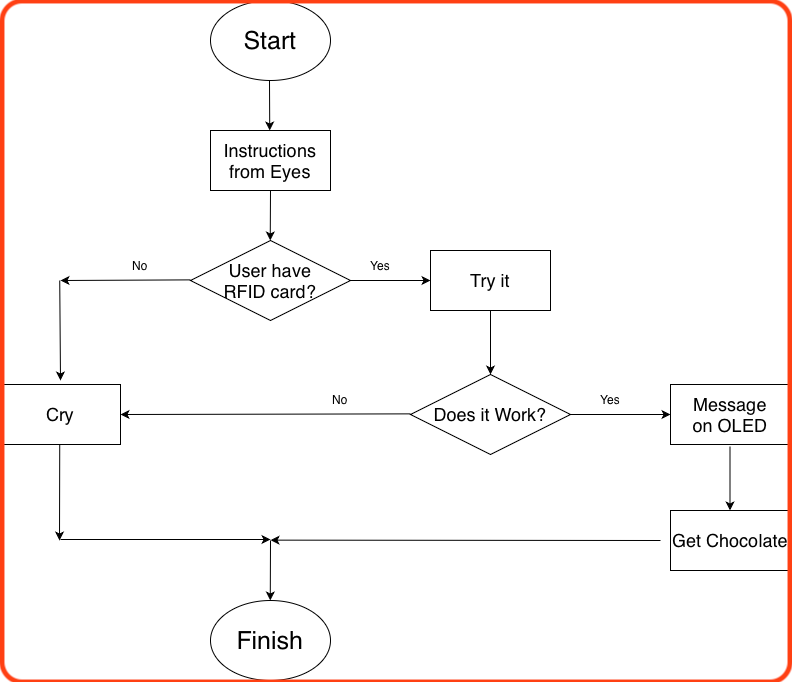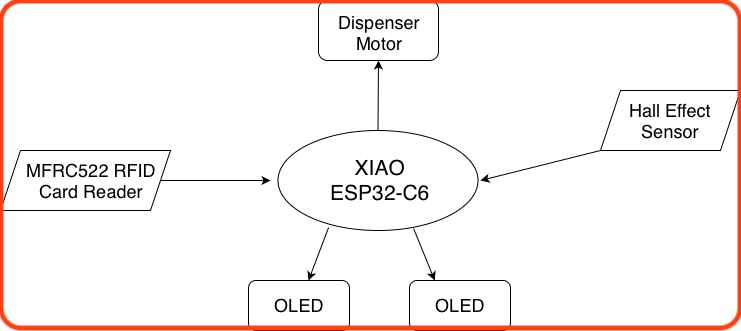Week 15: System Integration
Individual Assignment: Design and document the system integration for your final project.
IBM or Apple? Brainstorm
A big question from this year's lecture was to be IBM or Apple. IBM made block-like computer systems, whereas Apple's design came with style. Clearly we see which is the superior.
Unfortunately, the first prototype of our project is rather blocklike as IBM's computers:

The issue is that the head is unnecessarily big, and lacking grace. It has too much extra space. Let's consider again what we'd need to be inside, and then see how to redesign in a smaller form.
- stack of chocolate candies
- candy dispensing mechanism with motor
- microcontroller/PCB
- RFID card reader
- OLED display (ideal)
- Speaker (ideal)
We might add even more additional features, such as a camera, additional motor to rotate the head or arms, ability to dispense cash or other items, but the minimalistic version of the project can indeed be just a fraction of the original size considered. Although at the moment we will forego a camera module, we will include WIFI for communication.
Small is Beautiful
In fact, the entire project could fit in the model of the CNC project which we cut from cardboard:

As discussed in lecture, there are many ways in which a project can fail. It requires consistent and sustained testing to ensure the project can continue to perform reliably for a long time. We want our project to withstand the wide variety of potential problems. The whole point of the project is that it IS remote, and therefore will need to work very reliably. The smaller size should help it work reliably.
Integration of Face and Dispenser: the two key physical components of the project are the exterior face and interior candy dispenser, we must consider their integration in design. Basically it's a design question of how we will fit the mechansim (with electronics) inside of the head. We can image opening the back of the head and we'd like to see a very neat arrangement of the controller and wires to the sensors, with the motor and dispensing mechanism firmly situated within also. This will be our main task.

User Flow:
Before continuing, let's consider the user's interaction with the project. Although the project is relatively simple, it is good to think through the process clearly.

Project Functionality:
We must also clearly consider all the peripherals and how they will interact.

Components:
0. XIAO ESP32-C6 Board
The main controller will be the ESP32-C6 recommended by Sheikh Saheen as it contains a WIFI module for communication amongst many beneficial features. The ESP32-C6 provides a large number of ports supporting all the major communication methods, so it should be possible to connect all our input/output devices. However, on further consideration, the available Xiao ESP32-C3 board should suffice, as it will also support the devices we want to include as can be observed in the following pinout. Image source.

1. MFRC522 RFID Card Reader
We'll use the RC522 which is the standard RFID module available everywhere. RFID cards will be easier to implement than facial recognition as we originally hoped, so in the interest of completing the project in this lifetime we will take this option.
The RC522 module supports all standard methods of communication: UART, I2C, and SPI. However, as SPI is supported and commonly used for it's high we will utilize this option. Anyway, here it is: image credit.

2. Hall Effect Sensor
The hall effect sensor that we used in week nine, is a wonderful, reliable and durable sensor hence perfect for our project. We will use the hall effect sensor here to determine when the motor should stop, that is it should not infinitely rotate and dispense all the candies. Note that in our case we will not be using a stepper motor such as the NEMA17. See the next section for more details. image credit.

3. VEX Robotics 393 Motor
It happens that we have available to us a very large amount of 393 Motors from VEX Robotics. These are simple 2-wire motors, but also strong, reliable, and easy to fix as needed. These aspects support our ardent desire to produce multiples of our project.

4. OLED displays
Our old and familiar OLED display, full documentation we did in the output week.

Here's a summary of the components to be integrated with their respective operating voltage

Schedule

Face
As mentioned, there are two parts of the project to produce and subsequently integrate. First is the face, which by extension might include the sides of face, i.e. the enclosure. In any case, here is design of face:

By plan the OLED boards will be integrated into the project as eyes. However, it is not imediately obvious how to make a design to insert them as eyes, due to the size of the OLEDs and their attached wires.

Mechanism
The design for the mechanism includes a place for the board and all the peripherals. It also includes a receptacle or cannister for the chocolates. Here is the design we'll print without the peripherals:

Here is the plan for the rotating blade. The blade is required to be very precise in terms of fitting within a circle, and the ideal position of the embedded magnet to trigger the Hall Effect.

After we printed and placed the components it looks like this:

System Integration
Initially I was in a hurry and wanted to produce a board, but Saheen refused, saying I need to make a complete design in Fusion. Actually he was right, it forced me to think more about the design in every possible detail. In particular it helped me to realize that a design partly from laser-cutter and partly from 3D-printer will be difficult to integrate, and this besides the fact that a laser-cut head will always maintain too much of a square and block-like shape. So we thought more about the design process now planning for the entire head-structure to be 3D-printed.

Here is the view from the backside. The motor and dispenser mechanism is located on the left side, while the board will be placed on the right. The stack of chocolates are located in a container in the center in such a way that they may be dispensed one-by-one. The chocolates may be restocked through the center square, which will normally be filled by an antenna which we'll design to fit snugly inside such that no one will know!

Saheen still wouldn't let me print it, because there were other aspects to first consider. For example how to fit the parts together. He directed me to a nice video about snap fits available here. Only after watching this video, learning the technique, making a small test print, and applying it to my design. Only then did I print, so please see below the face attached by snap fits to the mechanism plate.

Design Files:
Face (Fusion 360)Dispenser (Fusion 360)
Snap Fit Test (Fusion 360)